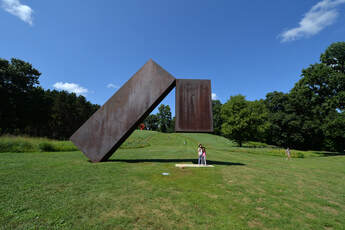
There are indoor galleries nearby, but Storm King isn’t a museum in any static sense. Throughout its 60-year history, the sculpture park has more than doubled in size, with its borders currently occupying some 500 acres. Its curatorial ambitions have grown, too, and its landscape now accommodates pieces both permanent and ephemeral. During the current pandemic, with indoor museums seeming less appealing, the art center has become a bona fide destination—tickets are now selling out weeks in advance, making Storm King one of the hottest New York art spaces right now.
But before it became the sensation it is currently, Storm King started out relatively small. “The project began as a family-led institution,” John Stern, the president of Storm King since 2008, told ARTnews. “My grandfather started this from his love of the Hudson Highlands.”
When they purchased the Vermont Hatch estate in Mountainville in 1959 that would later become Storm King, metal manufacturers Ralph “Ted” Ogden and H. Peter Stern envisioned a more modest operation. Ogden planned an indoor museum dedicated to the paintings of the Hudson River School, to be housed in the French-inspired stone chateau on the grounds. Nothing about the area was picture-perfect, however: the estate was in disrepair; construction of the New York State Thruway had displaced millions square yards of gravel from the farmlands, depriving the landscape of natural protection from the elements; and nearby cedars and dogwoods were choked with vines and poison ivy.
Stern, Ogden’s son-in-law, would go on to manage the administrative side of the operation, while Ogden guided the aesthetics with the assistance of landscape architect William A. Rutherford, Sr. Together they filled depressions, softened the hillside, built walkways, and restored the gardens. Later, it was decided the diseased Red Pines were to be replaced with White Pines on a yearly basis. (The grounds are a work in eternal progress.)

 RSS Feed
RSS Feed